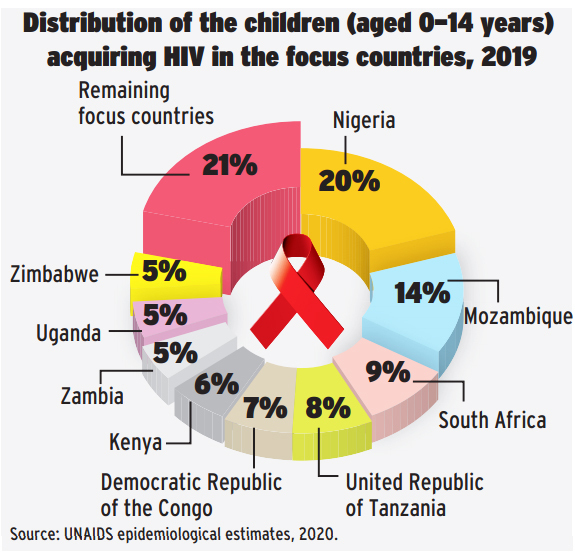5,500 children contracted HIV last year — Report
The increase in new infections among children is because of the stigma born out of HIV-related criminalisation and the unsupportive environment for HIV-positive new mothers.
HEALTH | HIV/AIDS
Over 5,500 children, aged 14 years and below, contracted HIV last year, according to a new report by the United Nations HIV/AIDS agency (UNAIDS).
The 2020 report on the progress towards the ‘Start Free, Stay Free, AIDS Free' targets reveals that the children contracted HIV from their mothers either during pregnancy, delivery or breastfeeding.
This shows an increase of 1,500 in the number of children contracting HIV from their mothers, from the 4,000 infections that the health ministry recorded in 2018.
Basic concepts
The report tracks the progress of the targets that were made in 2015 by global partners under the ‘Start Free, Stay Free, AIDS Free' framework. The framework was based on three basic concepts.
The first concept was to ensure that all babies are born free of HIV through eliminating vertical transmission (mother-to-child); second is to prevent adolescent girls and young women from acquiring HIV as they grow up; and the third concept was to ensure that children and adolescents who acquire HIV are accorded the right to be identified, treated and cared for in a timely manner, with access to optimal antiretroviral (ARVs) therapy so that they can remain AIDS-free.
Cause
The report says the new infections among children happened because the treatment coverage for pregnant women only captured one aspect of what is leading to the new child infections.

"Among the focus countries, 38,000 new infections occurred because women living with HIV did not receive antiretroviral therapy during pregnancy and 29,000 because women dropped out of antiretroviral therapy, either during pregnancy or while breastfeeding.
A further 30,000 children were infected because women acquired HIV while pregnant or breastfeeding," the report notes.
It states that eliminating new HIV infections attributable to women not receiving treatment, requires diagnosing and providing antiretroviral therapy for 150,000 more pregnant women.
"Women living with HIV should preferably be receiving lifelong antiretroviral therapy before conception."
"Ideally, to minimise vertical transmission, women living with HIV should be diagnosed, treated and should have suppressed viral loads from the time of conception to the end of the breastfeeding period and for the rest of their lives," the report further notes.
Stigma
Margaret Happy Akiiki, the executive director of Advocacy for Quality Health-Uganda, noted that the increase in new infections among children is because of the stigma born out of HIV-related criminalisation and the unsupportive environment for HIV-positive new mothers.
"Last year, we had several cases of HIV-related criminalisation. To a large extent, it increased stigma among mothers.
We had several anecdotes from women living with HIV, who were worried about their lives, their livelihoods and being criminalised.
They were accused of intentional transmission and taken to a remand, where they stayed for several days without help," she said.
Akiiki said in 2019, there were also several cases of intimate partner violence, noting that mothers who tested positive and revealed their status to their partners were violated and/or abandoned by their husbands.
"The quality of counselling has also gone down. What we have now is education, not the quality we used to have and it becomes very challenging for the new mothers," she said.
However, Prof. Vinand Nantulya, the chairperson Uganda AIDS Commission, says Uganda's efforts in scaling down mother-to-child transmission of HIV has been excellent.
He said Uganda's fight against HIV/ AIDS has been successful, and the country has been able to achieve both its national and UN targets.
Some of the areas of success, according to Nantulya, include getting over 1.2 million people living with HIV on ARVs, out of the 1.4 million people, during his tenure.